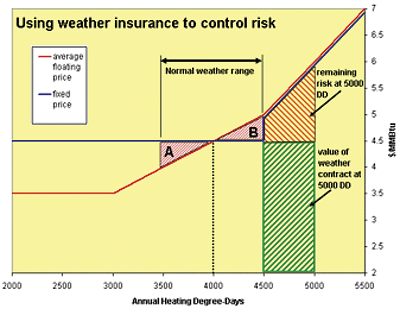
Imagine a 1-million-sq-ft office park in a northern climate of 4,000 degree-days (DD), plus or minus 500 DD. Such a facility annually consumes (at $4.50/Mtbu) $400,000 of firm gas (yielding an average cost of $100/DD). The price of fuel bought under a tariff containing a fuel adjustment charge floats with the weather: a mild winter sees an average price below $4.50, and a very cold winter blows the budget.
To control its costs, this facility signed a fixed price fuel contract covering a winter up to 4,500 DD, with a floating price for fuel needed during colder weather. In Figure 1, the horizontal blue line is the fixed price while the red line is the utility price for the same volume of fuel. At 4,000 DD, the fixed and average utility prices are the same. At 3,500 DD, buying from the utility saves a dollar amount (relative to the fixed price) represented by triangle A. At 4,500 DD, the fixed price saves an amount seen in triangle B. Since the fixed price contract has a limited volume, however, the price for fuel used above 4,500 DD is the same for either option.
Two Options
Two options are considered to control risk above that level: weather insurance and a physical hedge contract. The weather insurance option is pursued through a broker active at the Chicago Mercantile Exchange. Such insurance ensures that if the DD exceed a defined level, payments are made at a rate of $X per extra DD incurred. No fuel changes hands at any point; the deal is purely financial (just like insurance). Since the payment is directly proportional to temperature difference (and is unrelated to prevailing market pricing), this process is primarily designed to deal with extra fuel consumption (i.e., "volume risk"). As seen in Figure 1, the higher pricing seen between 4,500 and 5,000 DD creates additional cost risk. If the winter is normal or warm, however, the facility has only paid the premium for the contract (10% to 20% of its value were it to be fully used).
If the facility instead bought a commodity contract for extra fuel needed to cover an additional 500 DD, it would not need to take possession of the fuel but simply maintain title of the right to sell it. Some risk is involved if the weather became warm and extra fuel is not needed. In such a case, the hedge contract may be sold at a loss.

If The Weather Turned Cold
On the other hand (Figure 2), if the weather turned cold (thus increasing the value of the fuel), the facility would sell the contract at a price above that which it was bought, thereby covering the extra cost for the more expensive fuel physically taken from a utility or marketer. Once again, the transaction is purely financial, though a physical commodity served as the basis for valuation.To learn more about weather-related options, go to www.cme.com (Chicago Mercantile Exchange) and www.wrma.com (Weather Risk Management Association). For commodity contracts, speak to an energy broker active in your area.
While the usual due diligence (and a chat with your accounting people on tax issues) is necessary before signing anything, now is a good time to get up to speed: before it gets cold again. ES



